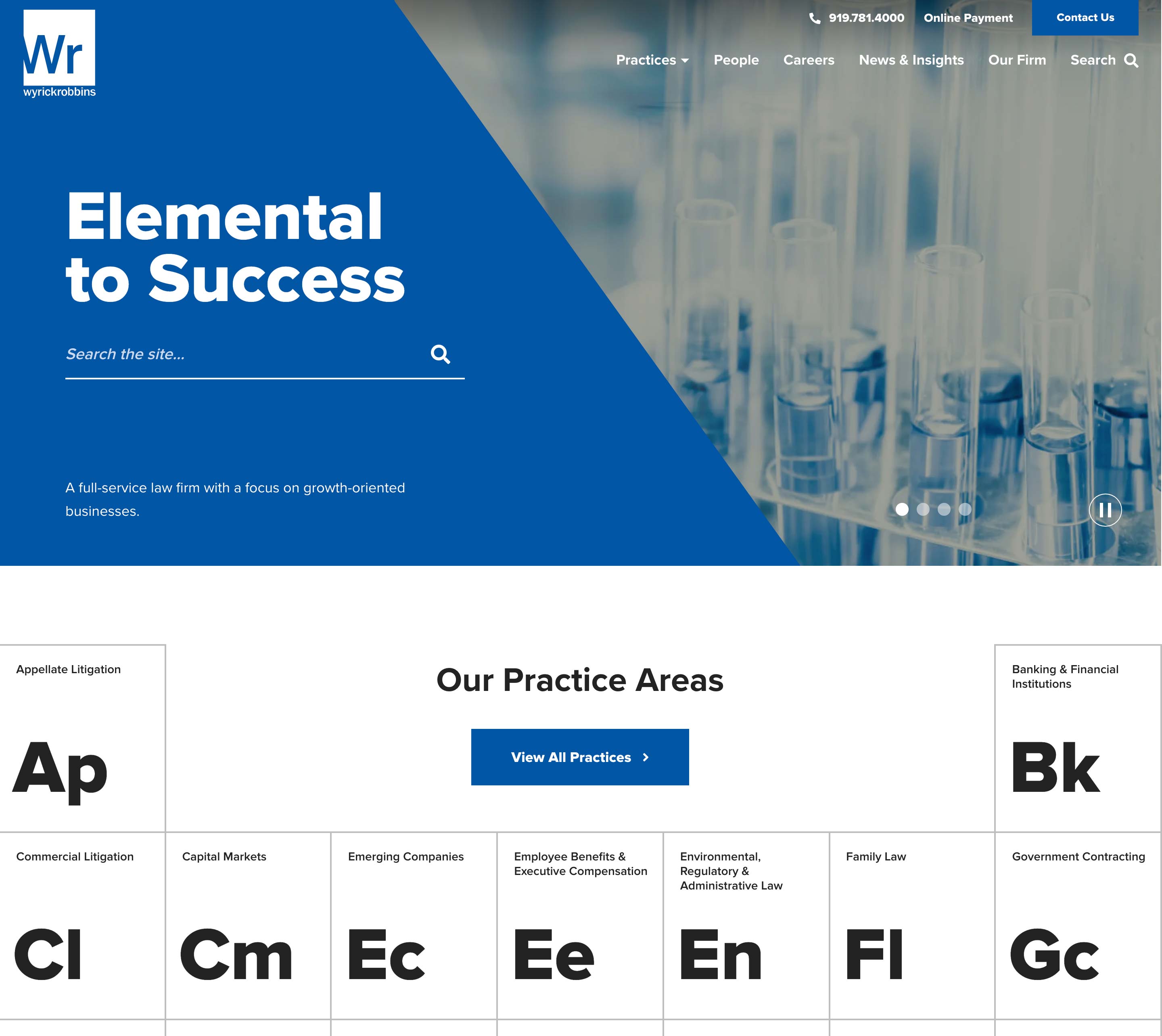Here at NMC, we work with our law firm clients to design and build sites that communicate effectively through a clear organizational structure. But because most law firms have multiple practice areas – and some of those tend to be more substantial in size, complexity, and revenue – we often run into the question of whether or not to separate the most active groups into individual microsites. An independent website and blog might be beneficial for an autonomous family law practice, but it might not be the best choice for a business law team that is deeply connected to the rest of the firm. This can be a complex issue, and there's no one-size-fits-all solution.
In this post, we’ll explore the pros and cons of utilizing microsites and offer our own suggestions for addressing common pitfalls.
Google Ranking Fundamentals
In order to understand when and how to split one site into several, you’ll first need to know some basics about domains, subdomains, directories, and how Google ranks properties around the web.
Instead of ranking full sites for broad queries, Google ranks a site’s individual pages. For example, NMC’s site is about web design in general, but we’re also able to rank an individual page for queries specific to a more targeted term like law firm website design. However, even though these individual pages are the ones that are optimized and ranked, Google still considers our entire domain’s strength, authority, legitimacy, and focus when making ranking decisions.
So, say you were looking at two pages on two different domains. Even if the pages are equally optimized and have all the same links pointing to them, the page with the stronger overall domain will win.
This fundamental truth about Google ranking is helpful to understand when making decisions about separating various initiatives or practice areas from your main site.
Google Ranking and Multiple Domains
When faced with practice groups that want digital autonomy, some firms choose to maintain separate domains for each category. This approach means creating a stand-alone website for each practice area that wants one. For example, fictional firm “ABC Law'' could use the domains abclawfirm.com, abcfamilylaw.com, and abcpatentlaw.com to separate practice areas onto their own sites.
While this may seem like a straightforward fix, using multiple domains comes with significant challenges. As noted above, Google rewards URLs/domains for their overall strength and authority. Because of this, you’d have to work really hard to juggle all of your domains and establish each site’s quality and value independently.
Even if you were able to build up each domain on its own, the sites would likely also face issues related to duplicate content, specifically around pages like attorney bios and about the firm where there's a lot of overlap with the main firm site. Copying content from other sites is generally known as a spammy practice, so Google penalizes sites whose content is identical or very similar to material that exists elsewhere on the web.
With all of this in mind, our typical recommendation is that practice areas should not be separated into their own domains. Separate domains make it hard to rank organically, introduce maintenance and technical concerns, and confuse individual users as they try to navigate between the multiple sites.
However, we know that a microsite is sometimes unavoidable. And in situations that require true autonomy, it can even be a good idea. So when a firm insists on some form of multiple sites, we tend to recommend the creation of subdomains.
Subdomains Explained
Put simply, a subdomain is the portion of text that precedes the main URL. It’s separated by a period, and appears like this: familylaw.abclawfirm.com.
Technically speaking, a subdomain can be a separate instance and site – it can be completely independent. Subdomains don’t have to share any of the main site’s platform or hosting, and they can be “pointed” at any server out there. It’s actually quite common for larger companies to have dozens of subdomains for each of their divisions, platforms, and teams. For a brand like Google, this can be seen as support.google.com, edu.google.com, blog.google.com, mail.google.com, and so on.
Subdomain Benefits
Subdomains offer several benefits. First, they allow the firm to maintain brand consistency. Instead of confusing site visitors with multiple URLs, the subdomain’s attachment to the main domain makes it clear that the sites are closely related to one another. For example, including the “ABC Law Firm” name in familylaw.abclawfirm.com signals to visitors that Family Law is an extension of the main firm.
Another key advantage of subdomains is that, even as separate sites, they still receive the SEO benefits from the main domain. Google views content on a subdomain with the same authority as a page hosted only on the main domain – i.e., familylaw.abclawfirm.com and abclawfirm.com/familylaw are the same in the eyes of Google. This is important because a primary site may have had years to build strength and link equity, whereas the smaller microsites have not. But because the microsites are attached to the main domain, all sites can benefit from the firm’s SEO strategy.
A third positive is that subdomains can offer the autonomy and independence that many practice groups are looking for. For a Family Law practice at an otherwise large firm, a subdomain might make the group seem more substantial than it would as a tab or interior page on the main site. Subdomains also grant the technical independence to manage the site on another platform or even contract with a different firm, if desired.
Subdomain Downsides
Even though subdomains are a great compromise for some law firms, they do bring one primary downside. No matter how seamless the navigation is set up to be, subdomains are not truly integrated into the main site. And for some users, that can be disconcerting.
The potential for disconnect can be mitigated by making it as easy as possible to access each site from the other. Our clients have done this successfully by clearly featuring a button or link to the main site in the microsite’s navigation bar.
It’s also important to note that because a subdomain is technically a separate website, it must be maintained and managed as such. If you choose to use one, you’ll be responsible for the upkeep of your main site along with each of its subdomains. Not necessarily a bad thing, but something to keep in mind if your time and resources are limited.
Subdomains In Practice
Recently we launched a new website and microsite for our client Wyrick Robbins. The firm’s primary site is modern, engaging, and chock full of resources about a wide range of legal topics. You can read more about it in our law firm website redesign case study on the project.

Wyrick also has a burgeoning Privacy & Data Security group, and their team wanted to create a blog dedicated entirely to content about privacy. The blog, Practical Privacy, is located on the subdomain practicalprivacy.wyrick.com.

We decided to go with a microsite because of the blog’s robust independent content and the group’s desire for a dedicated digital space. Had we placed the blog on the main Wyrick.com site, it may have confused visitors and competed with the firm’s blog-like News & Insights section. As its own entity, the Practical Privacy blog stands out as unique and separate from Wyrick’s primary site while still benefiting from the authority of the firm’s name.
The microsite itself incorporates signature colors, shapes, and fonts from Wyrick.com. By using many of the same design elements, the microsite remains consistent with the Wyrick brand and communicates to visitors that the two sites belong to the same firm.
In addition to showing the relationship visually, the microsite clearly links back to Wyrick.com with a prominent button at the top right corner of each page. This makes it quick and easy for visitors to return to the main site.

For Wyrick Robbins, a microsite was a great way to showcase specific content that couldn’t really be accommodated on the firm’s main website. Practical Privacy has been successful so far, and Wyrick’s team keeps it well updated with the latest news and information.
Conclusion
Without a doubt, there’s a lot to consider when deciding whether or not to separate your firm’s practice areas into individual microsites. Microsites do bring independence, but they also introduce the potential for user confusion and require the same amount of oversight as any other website.
So in the end, the microsite decision really comes down to your firm’s needs, your willingness to invest time and energy in the subdomains, and the amount of value that you (or your practice groups) place on separation. They’re not perfect for every situation, but we do think that they’re a worthwhile consideration for a law firm or company seeking to differentiate robust resources or service offerings.





Leave the first comment